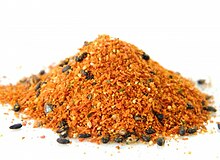Shichimi
 Shichimi tōgarashi | |
| Alternative names | Nana-iro tōgarashi |
|---|---|
| Type | Spice mixture |
| Place of origin | Japan |
| Invented | 17th century |

Shichi-mi tōgarashi(ThấtVịĐường tân tử,seven-flavor chili pepper),also known asnana-iro tōgarashi(ThấtSắcĐường tân tử,seven-color chili pepper)[1][2]or simplyshichimi,is a commonJapanesespice mixturecontaining seven ingredients.[3]Tōgarashi is the Japanese name forCapsicum annuumpeppers, and it is this ingredient that makes shichimi spicy.[4]
Etymology
[edit]“Shichi” means seven, and “togarashi” is the red chili pepperCapsicum annuum.[5]The blend is also called nanami togarashi.[5]
Ingredients
[edit]A typical blend may contain:
- coarsely ground redchili pepper(the main ingredient)
- groundsanshō( "Japanese pepper" )
- roastedorangepeel (chenpi)
- blacksesame seed
- white sesame seed
- hempseed[6]
- groundginger[3]
- norioraonori(seaweed)
- poppy seed[5]
- yuzupeel[5]
Some recipes may substitute or supplement these withyuzupeel,rapeseedorshiso.Shichimi is distinguished fromichi-mi tōgarashi(NhấtVịĐường tân tử,ichimi, one-flavor chili pepper),which is simply ground red chili pepper.[7]
Use
[edit]The blend is traditionally used as a finishing spice. It is ubiquitous in restaurants in Japan; a shaker is sometimes on every table along with salt and pepper shakers and bottles of soy sauce.[5]It is often consumed with soups and on noodles andgyūdon.Some rice products such asrice cakes,agemochiand roastedrice crackersalso use it for seasoning.[8]
History
[edit]
Shichimi dates back at least to the 17th century, when it was produced by herb dealers inEdo,[3]current day Tokyo, and sometimes it is referred to asYagenbori(DượcNghiênQuật,from the name of the original place of production).Most shichimi sold today come from one of three kinds, sold near temples: Yagenbori(やげん quật)sold nearSensō-ji,Shichimiya(Thất vị gia)sold nearKiyomizu-dera,and Yawataya Isogorō(Bát phiên ốc cơ ngũ lang)sold nearZenkō-ji.[citation needed]
Culture
[edit]In modern times, the product is generally sold as a formulated product, but in the past it was prepared and sold according to the customer's needs ( thất vị đường tân tử mại り). Even today, performances can be seen at festival stalls.
-
This is a performance of mixing spices while explaining their benefits.
See also
[edit]References
[edit]- ^Nihon Kokugo Daijiten(dictionary).
- ^Shin Meikai kokugo jiten(dictionary).
- ^abcZeldes, Leah A.(2010-04-14)."Eat this! Shichimi togarashi, zesty Japanese seasoning".Dining Chicago.Chicago's Restaurant & Entertainment Guide. Archived fromthe originalon 2010-10-07.Retrieved2010-05-22.
- ^Gordenker, Alice, "Shichimi Togarashi: The Japanese 7-Spice Mix You Have to Try",Japanese Food Guide
- ^abcdeKim, Eric (2023-10-04)."This Store-Bought Spice Blend Makes Everything Taste Better".The New York Times.ISSN0362-4331.Retrieved2023-10-07.
- ^Hongo, Jun (Dec 11, 2007)."Hemp OK as rope, not as dope".The Japan Times.Retrieved2010-05-22.
- ^Kaneko, Amy (2007).Let's Cook Japanese Food!.Chronicle Books. p. 20.ISBN978-0-8118-4832-9.
- ^Kilcoyne, Kevin (3 February 2020)."Shichimi: The Seven Spice Blend of Japan".Kokoro Care Packages.Retrieved14 April2024.
and can even be found as a flavor for rice crackers and agemochi


